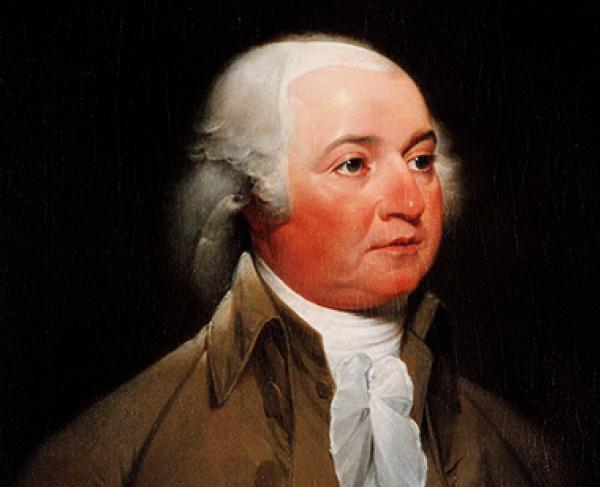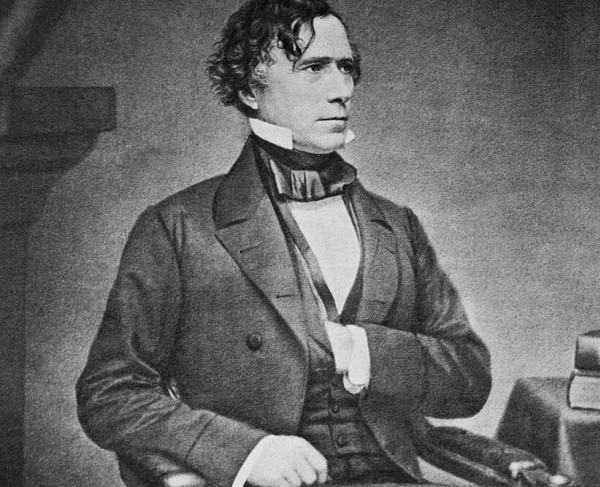John Adams

President John Adams was born in Braintree, Massachusetts, on October 30, 1735. Growing up, Adams received a valuable education from a local Latin school, where he learned Latin, rhetoric, arithmetic, and philosophy. At sixteen, he entered Harvard University to study under Joseph Mayhew. Adams received high praise during his time of study and, upon graduation, received a teaching job. After four years of teaching, Adams returned to Harvard, decided to become a lawyer, and studied under leading lawyer James Putnam. Adams was admitted to the bar in 1759 and began practicing law and observing court cases in Boston. As his career progressed, he kept journals of his and others' legal cases to study to become a better lawyer. In 1759, John Adams met his fifteen-year-old third cousin Abigail Smith; they did not immediately fall in love, but as time progressed, the pair eloped in October of 1764. Together, John and Abigail had six children, including future president John Quincy Adams.
As tensions rose in the colonies, colonists began to protest British rule. In 1765, there was widespread resistance to the Stamp Act. Adams used a pen name and wrote opposition articles for the Boston Gazette. In addition to Adam's written protest, famous cousin Samuel Adams led the charge in physical protest, including public demonstrations. He moved his family to Boston to continue his law practice and defended big-name clients like John Hancock. Adam's constant success made him the most prominent lawyer in Boston. Still, he would gamble with his new reputation when representing British Captain Thomas Preston and his men involved in the Boston Massacre. During the evening of March 5, 1770, colonists were furious with the Townsend Acts. The mob began to protest by antizoning stationed British soldiers by throwing chunks of ice while shouting obscenities. British soldiers fired into the crowd, killing five people, including Crispus Attucks, as the crowd got larger and unruly. Despite Adams, patriotic beliefs, he believed it was his duty to ensure the British soldiers received a fair and even trial. During the trial, Adams persuaded the jury that Captain Preston couldn't tell his men to fire due to the noise from the violent protest. Only two out of the eight were charged with manslaughter, and Adam's positive reputation continued to grow.
In 1773, the hostility between the colonist and Great Britain could no longer be ignored when the Sons of Liberty, led by Samuel Adams, participated in the Boston Tea Party. The colonist destroyed 10,000 pounds of tea by dumping it into the Boston Harbor. As a response, the British passed the Boston Port Act that required the citizens of Boston to repay the East India Trading Company. The following year Adams was present at the meeting of the First Continental Congress. The meeting discussed a unified response to the Intolerable Acts and created a draft letter of grievances for King George III. In 1775, news of the first battle at Lexington and Concord propelled Adams and other patriots toward the reality of Independence. In May of 1775, the meeting of the Second Continental Congress met in Independence Hall in Philadelphia. Adams continued to represent Massachusetts and played vital roles in decision-making, including the election of George Washington as Commander of the Continental Army.
While serving in congress, Adams worked to establish a Continental Navy to aid the army during the Revolutionary War. Congress established the Marine Committee, which consisted of Adams, John Langdon, and Silas Dean. The group was authorized to purchase substantial amounts of guns and ships and establish a Marine Corps. On December 3, the first American fleet was commissioned, and eight more vessels were constructed. In 1776, Adams organized a "Committee of Five" and was placed in charge of drafting the Declaration of Independence. The five-member included John Adams, Benjamin Franklin, Thomas Jefferson, Robert Livingston, and Robert Sherman. Adams convinced Jefferson to write the document due to his advanced writing skills and positive reputation. Despite Adam's popularity, he was often seen as "obnoxious" by his fellow congress members. Jefferson wrote the first draft on July 1, Adams pushed the document through congress, and on July 4, the Continental Congress voted to adopt the Declaration of Independence.
As the war continued, Adams served as the head of the War and Ordnance Board, keeping records of the men who served and the supplies needed for the army. In 1777, the congress sent Adams to join Franklin in France and help convince the monarchy for an alliance. After his time in France, the congress sent Adams to Britain in 1779 to negotiate a commercial treaty and aid in discussions about ending the war. After Britain, the congress sent Adams to the Dutch Republic to secure additional alliances and a loan. In 1781, Adams received news of the British surrender at Yorktown and was reassigned to negotiate the Treaty of Paris. The Treaty was officially signed On September 3, 1783, granting the United States independence. Post-revolution, Adams continued his diplomatic service as the first appointed ambassador to Great Britain.
Mid-1788, Adams returned to Massachusetts and was greeted warmly by his friends and family. The following year, in 1789, Adams was elected Vice President of the United States under George Washington's administration. Adams presided over the Senate as a Federalist and worked closely with other cabinet members, including Alexander Hamilton and Thomas Jefferson. At the end of Washington's presidency, Adams and Jefferson campaigned against each other in the election of 1796. With support from Alexander Hamilton and his fellow Federalists, John Adams became the second President of the United States. During his presidency, Adams faced many domestic and international controversies, including the XYZ affair, the Alien and Sedition Acts, and the beginning of the Quasi-War with France. Adams also successfully rebuilt the United States Navy, giving him the title "the father of the American Navy" and passing a law establishing the Library of Congress. Adam ran for reelection in 1800 against Thomas Jefferson and Arron Burr and did not receive enough votes.
John Adams returned to his home in Peacefield, Massachusetts, where he farmed and wrote privately on political matters. Although Adams and Jefferson had a rocky relationship, during their retirement years, the pair stayed connected and discussed personal and ongoing political issues. On July 4, 1826, John Adams died at the age of 90; as he was dying, his last words were, "Thomas Jefferson survives," unaware that Jefferson had died only hours earlier.


